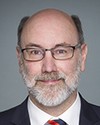I strongly believe there is a lack of Canadian evidence. I've been reviewing this issue for quite some time. I find myself with a significant lack of data that can support any type of assessment of possible mitigation measures.
I was referring to our NEF contours, particularly with outdated metrics that are currently used as guidelines by Transport Canada. Our NEF contours are primarily meant as a land planning tool. Essentially, they predict the noise into the future and how it's going to impact the ground level.
The thresholds currently set forth by Transport Canada are NEF 30, as being inappropriate for noise sensitive development, and NEF 25, which needs to be treated with some acoustic insulation.
In any case, these guidelines have not been reviewed or corroborated by Canadian annoyance surveys, which are the tools used to predict how many people will be annoyed at those exposure levels. These guidelines were set in the 1970s, based on an analysis done in the U.S. for multiple transportation sources, not aircraft noise alone. Many countries across the world have undertaken efforts to review these thresholds and the metrics they use to be better equipped to predict the effects of aircraft noise on communities around air paths or airports.
If we don't have an updated version of a metric like this or guidelines like these, even the measures currently taken in land use and planning are not effective.
There's been a shift. There's an increasing trend in aircraft noise annoyance at lower levels. This is not taken into account currently.




